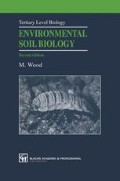Abstract
The first three chapters of this book have considered the various components of soil, and some of the underlying biochemical processes which make soil one of the most fascinating living materials. Some scientists have been drawn to consider soil as a living tissue, with the soil solution acting like blood, transporting nutrients and waste products.
Access this chapter
Tax calculation will be finalised at checkout
Purchases are for personal use only
Preview
Unable to display preview. Download preview PDF.
References
Berthelin, J. (1983) Microbial weathering. In Microbial Geochemistry, ed. Krumbein, W.E., Blackwell Scientific Publications, Oxford, pp. 223–262.
Darwin, C. (1881) The formation of vegetable mould through the action of worms. In The Essential Darwin, ed. Ridley, M. (1987), Allen and Unwin, London, pp. 237–256.
Fyfe, W.S., Kronberg, B.I., Leonardos, O.H. and Olureunfemi, N. (1983) Global tectonics and agriculture: a geochemical perspective. Agriculture, Ecosystems and Environment 9, 383–399.
Haynes, R.J. (1983) Soil acidification induced by leguminous crops. Grass and Forage Science 38, 1–11.
Hillel, D.J. (1991) Out of the Earth. Civilization and the life of the soil, The Free Press, New York.
Jenkinson, D.S. (1981) The fate of plant and animal residues in soil. In The Chemistry of Soil Processes, ed. Greenland, D.J., John Wiley and Sons, Chichester, pp. 505–561.
Jenny, H. (1980) The Soil Resource: Origin and Behaviour, Springer-Verlag, Berlin.
Lynch, J.M. and Bragg, E. (1985) Microorganisms and soil aggregate stability. In Advances in Soil Science, Volume 2, ed. Stewart, B.A., Springer-Verlag, Berlin, pp. 133–171.
Miles, J. (1985) The pedogenic effects of different species and vegetation types and the implications of succession. Journal of Soil Science 36, 571–584.
Molloy, L. (1993) The Living Mantle. Soils in the New Zealand Landscape, New Zealand Society of Soil Science, Lincoln, New Zealand.
Nye, P.H. and Tinker P.B. (1977) Solute Movement in the Soil-Plant System, Blackwell Scientific Publications, Oxford.
Passioura, J.B. (1988) Water transport in and to roots. Annual Review of Plant Physiology and Plant Molecular Biology 39, 245–265.
Satchell, J.E. (1983) Earthworm Ecology From Darwin to Vermiculture, Chapman and Hall, London.
Schatz, A. (1963) Soil microorganisms and soil chelation. The pedogenic action of lichens and lichen acids. Journal of Agricultural and Food Chemistry 11, 112–118.
Simonson, R.W. (1959) Outline of a generalized theory of soil genesis. Soil Science Society of America Proceedings 23, 152–156.
Swift, M.J. and Boddy, L. (1984) Animal-microbial interactions in wood decomposition. In Invertebrate—Microbial Interactions, eds. Anderson, J.M., Rayner, A.D.M. and Walton, D.W.H., Cambridge University Press, Cambridge, pp. 89–131.
Swift, M.J., Heal, O.W. and Anderson, J.M. (1979) Decomposition in Terrestrial Ecosystems, Blackwell Scientific Publications, Oxford.
Wood, T.G. (1976) The role of termites (Isoptera) in decomposition processes. In The Role of Terrestrial and Aquatic Organisms in Decomposition Processes, eds. Anderson, J.M. and Macfayden, A., Blackwell Scientific Publications, Oxford, pp. 145–168.
Author information
Authors and Affiliations
Rights and permissions
Copyright information
© 1995 Springer Science+Business Media Dordrecht
About this chapter
Cite this chapter
Wood, M. (1995). Soil formation and development. In: Environmental Soil Biology. Experimental and Clinical Neuroscience. Springer, Dordrecht. https://doi.org/10.1007/978-94-011-0625-2_4
Download citation
DOI: https://doi.org/10.1007/978-94-011-0625-2_4
Publisher Name: Springer, Dordrecht
Print ISBN: 978-0-7514-0343-5
Online ISBN: 978-94-011-0625-2
eBook Packages: Springer Book Archive

